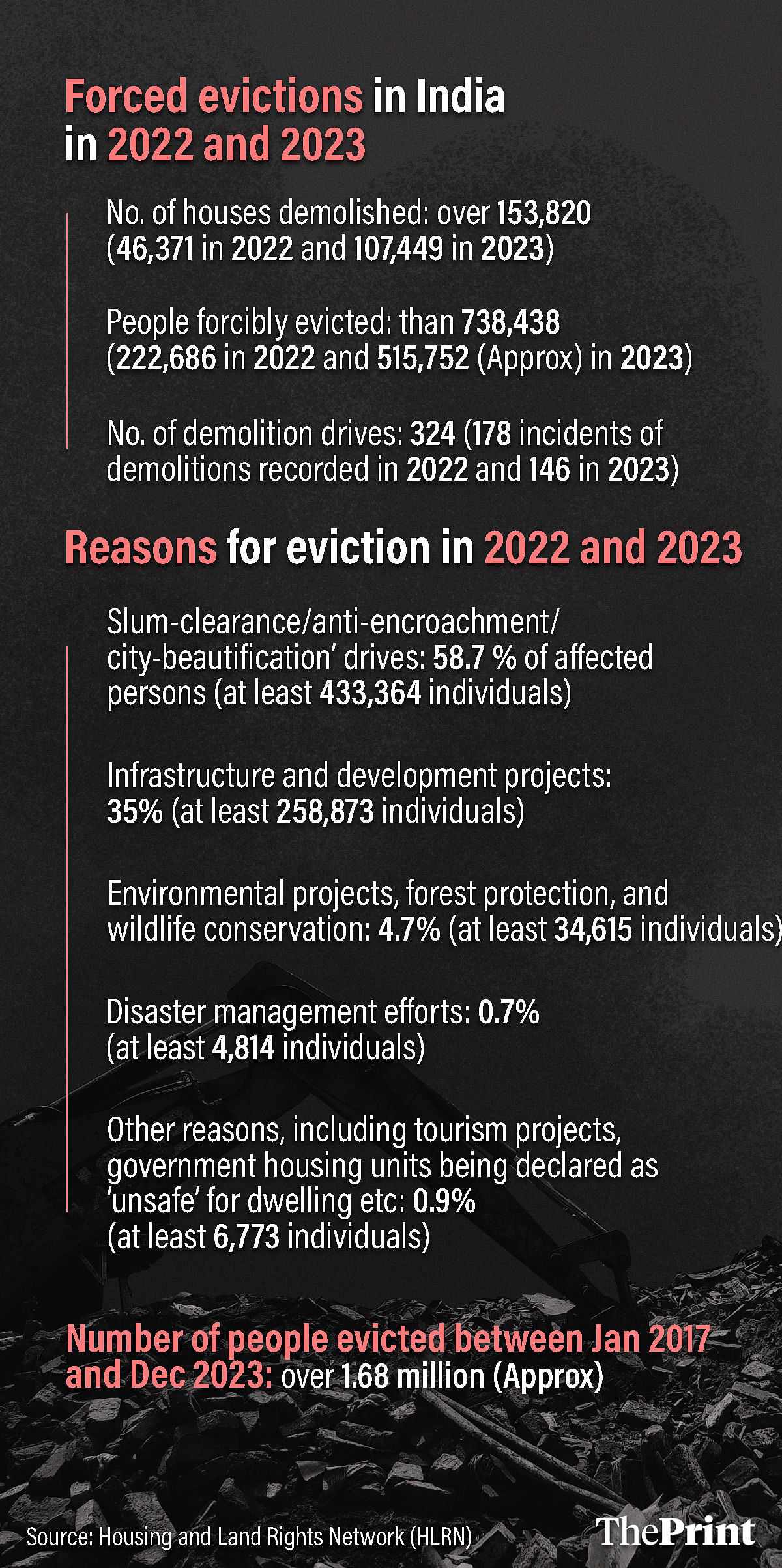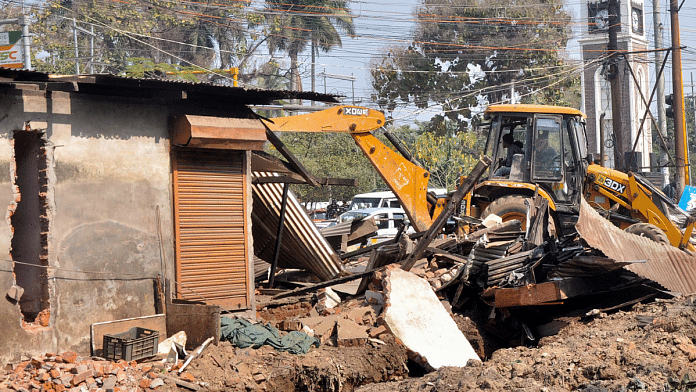New Delhi: Around 94 percent of the total 7.4 lakh Indians evicted from homes in the past two years were mainly because of encroachment removals, beautification and infrastructure projects undertaken by government authorities, according to a report released Monday by the Housing and Land Rights Network (HLRN).
The report, ‘Forced Eviction in India- 2022 and 2023’, said that of the 7,38,438 people evicted between January 2022 and December 2023, 58.7 percent (4.33 lakh) were evicted because of slum-clearance, encroachment removal and city beautification drives and 35 percent (2.58 lakh) due to development projects such as widening of roads, construction of highways and bridges and ‘smart cities’.
Delhi-based HLRN has been publishing reports on forced evictions in India since 2017. The non-profit organisation, which works on housing and land rights, had set up the National Eviction and Displacement Observatory in 2015 to compile forced eviction-related data.
Many of those evicted are from marginalised communities, including Muslims, Scheduled Castes and Scheduled Tribes, and a large percentage of them live in informal settlements in urban and rural areas. The largescale demolition drives “not only disproportionately affects the poor and increases their vulnerabilities, but also aggravates the housing shortage” in the country, the report said.
According to the report, the highest number of evictions and displacements since 2017 (when HLRN first published its findings) was recorded in 2023 with over one lakh (1,07,449) homes demolished, resulting in the forced eviction of at least 5,15,752 people across the country.

“The reasons for these evictions are varied, but the pain and suffering faced by those who lose their homes remains a poignant reminder to the rest of us of the price people have to pay for urban development, infrastructure creation, and environmental conservation, or even for ‘beautification’ of cities,” HLRN executive director Enakshi Ganguly told ThePrint.
The report cites the example of Delhi where large scale demolition was carried out at over 70 sites to remove encroachments and for ‘beautification’ projects in the past two years. “A spate of evictions and demolitions occurred in Delhi before the G20 Summit in September 2023…In 2023, around 2.8 lakh people were evicted by state authorities in Delhi, the highest in any location in India in the year,” it said.
Apart from Delhi, states such as Haryana, Uttarakhand, Bihar, Rajasthan carried out major encroachment removal drives and city beautification projects. BJP-ruled states such as Gujarat, Uttar Pradesh, Madhya Pradesh and Maharashtra (where it is part of the ruling coalition) are among the few states where majority of evictions took place for infrastructure development projects.
Road-widening projects in cities such as Ahmedabad, Coimbatore, Guntur, Delhi, Mumbai, Patna, Prayagraj, Vadodara, and Ujjain; construction of highways and expressways in Bhagalpur, Delhi, Indore and Mumbai; expansion of railway lines in Bhopal, Mumbai, and Surat and river-front development projects (Ahmedabad, Delhi, Indore, and Lucknow) are some of the examples cited in the report.
The other reasons for forced evictions include environmental projects, forest protection, and wildlife conservation (4.7 percent); disaster management efforts (0.7 percent) and other reasons (0.9 percent), as per the report.
The report documents incidents of forced evictions in 23 states and four Union Territories in the past two years. Apart from megacities such as Delhi, Mumbai, Kolkata, Tier 2 and 3 cities such as Ayodhya, Daman, Jaisalmer, Dwarka, etc have also reported forced eviction in the last two years, as per the report.
Also Read: Parliamentary panel tells Centre to identify reasons for ‘slow pace’ of its Smart Cities Mission
‘Marginalised section of society affected’
According to the report, the forced evictions have severely impacted the people belonging to marginalised groups as well as other marginalised communities in several states such as Assam, Bihar, Delhi, Gujarat, Madhya Pradesh, Manipur, Odisha, Punjab, Tamil Nadu, Telangana, Tripura and Uttar Pradesh.
Out of the 324 cases of evictions reported in the past two years, HLRN documented information regarding caste, religion and other identities of people affected in 101 cases. “In 2023, at least 53 instances (36 percent of the total reported instances) of evictions documented affected marginalized groups, while in 2022, in 48 instances (27 percent) marginalised groups were affected,” the report said.
“Within the subset of these 101 documented cases, where information was available, Muslims emerged as the most affected group in almost half (44 percent) of instances, underscoring their particular vulnerability in the context of forced evictions and displacement.”
From 2017 to 2023, state agencies forcibly evicted over 1.68 million (16.8 lakh) people in rural and urban India, said the report. But little has been done over the years by them to provide adequate housing to these people.
Of the total 324 instances of forced evictions recorded in 2022 and 2023, HLRN said that information on resettlement is available only for 122 instances.
“Among (the 121 instances) these, the state offered some form of resettlement or alternative housing in only 25 of the affected sites (20 percent of total instances); partial resettlement in seven sites (1.6 percent of total instances); and monetary compensation in only seven sites (5.7 percent of total instances). This implies that, in 69 percent of instances of eviction in 2023 and 2022, where information is available, the state failed to resettle or rehabilitate affected persons,” it said.
In its previous report, ‘Forced Eviction in India in 2021’, which was released in 2022, HLRN had said that the government had not resettled or compensated at least 59 percent of the people evicted.
As the poor marginalised sections were among the worst affected due to the eviction drives, HLRN reiterated its demand for “national moratorium on forced evictions and home demolitions”.
“Develop a comprehensive housing policy aimed at providing durable solutions for adequate housing for all. This should include the adoption of a ‘housing first’ approach to prioritise adequate housing for homeless persons and the provision of low-cost housing options along a ‘housing continuum,’ including hostels for migrant workers and single homeless persons, collective housing arrangements, and social rental housing,” the report recommended.
It further suggested the central government to recognise and list all informal settlements as legitimate clusters of housing to remove connotations of ‘illegality’ and ‘encroachment’, provide for low-cost, affordable housing, provide alternative accommodation to people who have lost their homes and conduct a survey of migrants and poor people without houses in cities.
(Edited by Tony Rai)
Also Read: Both BJP & AAP promised ‘jahan jhuggi, wahan makan’, but Delhi slum redevelopment sees slow take-off



